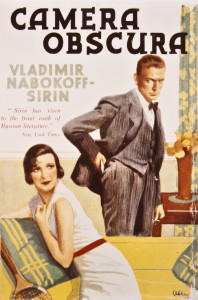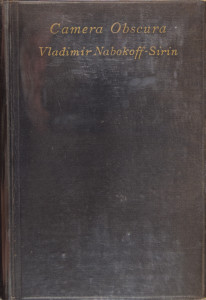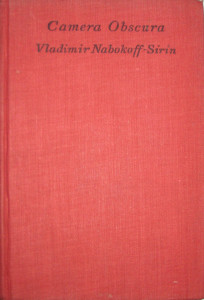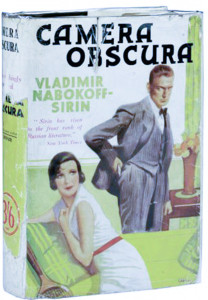
1936 John Long Camera Obscura, dust jacket front
John Long, an imprint of the British publisher Hutchinson, issued the first translation of Nabokov’s 1933 Russian novel, Камера обскура, into English as Camera Obscura in January 1936 in black cloth-covered boards with gilt stamping and with a dust jacket illustration, by an artist named Abbey, of a man in a three-piece pinstripe suit glaring intensely at an awkwardly seated woman. The translation was credited to a Winifred Roy.
John Long royalty statements (in the Nabokov holdings of the New York Public Library’s Berg Collection) show that 567 sets of sheets of Camera Obscura were printed. The sheets were warehoused and then bound and shipped according to John Long’s marketing needs.
First released were full price copies into the domestic market at 7/6 (i.e., seven shillings and six pence) on 2-Jan-1936. Only 99 copies were sold. At about the same time, John Long, following standard British publishing practice of the time, shipped copies overseas to countries and colonies of the British Empire for sale at less than the full price edition, probably six shillings. These were bound with a preliminary sheet pointing out that the copy was for sale only in a restricted area of the British empire. (See http://nzetc.victoria.ac.nz/tm/scholarly/tei-GriBook-_div3-N11A1D.html) John Long records that only 10 such copies were sold.
Eventually, John Long, following its standard practice of re-releasing at a lower price point 7/6-priced books that didn’t sell out, issued Camera Obscura in its “cheap” line at 3/6. One-hundred fifty-seven cheap copies were sold. Last of all were 277 copies sold at an unknown, remaindered price. A dozen copies were recorded as “free”, probably for the author, reviewers, promotions, etc. That left 12 sets of sheets unaccounted for.
Of the 567 possible bound copies of Camera Obscura, only a stackful survive. Those still in their dust jackets are even rarer. I’ve been able to track three such copies: one at the Berg Collection and which had previously been Nabokov’s own copy; a depository copy at the Cambridge University Library; and, one unsuccessfully offered three times (2002, 2005, 2008) by Sotheby’s in London, for which I have little information. Ten other institutional copies, almost certainly without dust jacket, are listed on WorldCat and multiple others are in private hands or dealers’ catalogs. The surviving population, with and without dust jacket, therefore is minimally a couple dozen.
The copies I’ve examined and the citations I’ve found reveal several points regarding bindings, dust jacket spines, and advertisements. For each point, the findings are listed in their probable order of issue. First are the bindings:
- Binding a – Black cloth-covered boards with gilt stamping;

Binding a in black cloth with gilt stamping.
- Binding b – Red cloth-covered boards with black stamping;

Binding b in red cloth with black stamping.
- Binding c – Wrappers (cited but unobserved).
Then are the dust jacket spines:
- Dust jacket spine a – Black and red lettering on a white ground (reading from the top down: title, blurb, author’s name, price at 7/6, and publisher’s name);

Issue a, dust jacket spine.
- Dust jacket spine b – A strip, overlaying the original spine, with black and red lettering on a yellow ground (reading from the top down: probably (because of incomplete information on a poorly preserved spine) the author’s name, title, two lines mentioning Despair, price at 3/6, and probably the publisher’s name).

Dust jacket with spine b
In addition, bound into each copy is a concluding separately paginated signature of advertisements for John Long books. Those signatures are listed here in their probable chronological order. (Be aware of John Carter’s admonition in ABC for Book Collectors that when using bound-in advertisements to assess priority of issue, one must use the evidence with great caution.):
- Advertisement set a – Sixteen pages headed “JOHN LONG | Books | SUMMER LIST, 1935”. There are 11 pages for summer 1935 books, three pages for spring 1935 books, one for cheap editions, and one for a writing competition “…for a mystery or detective novel to be submitted…not later than 1st July, 1935…”. There is no mention of Camera Obscura or the 1937 John Long Despair anywhere in the ads;
- Advertisement set b – Sixteen pages headed “JOHN LONG’S NEW BOOKS”. Page one has the further heading “GENERAL”, encompassing eight pages of listings and page nine is headed “NOVELS” and encompasses eight pages. Camera Obscura is advertised on p. 10. There is no mention of Despair;
- Advertisement set c – Sixteen pages headed “JOHN \beginning of publisher’s rectangular device\ LONG’S | NEW \continuation of publisher’s rectangular device\ BOOKS”. There are 15 pages, plus one page for “RECENT NOVELS”. Camera Obscura is advertised on p. 9 and subheaded “Author of ‘Despair’”. But there is no separate listing for Despair;
- Advertisement set d – Four pages headed “JOHN LONG’S 3/6 LIBRARY | LOVE, LIFE & ROMANCE”. There is no mention of Nabokov or either of his two John Long titles. The fact that all of the books listed here are part of the “3/6 Library” implies that these advertisements were intended to be bound in with a John Long book selling at 3/6.
We come now to the actual copies examined:
- Binding a, dj spine a, advertisement set a;
- Binding a, dj spine a, advertisement set b;
- Binding a, unknown dj, advertisement set c;
- Binding b, unknown dj, advertisement set d;
And the copies, unexamined, with incomplete citations:
- Binding b, unknown dj, four pages of ads that are possibly advertisement set d;
- Binding c, unknown dj (if any), unknown ads, released in 1938.
With this information in hand, I have parsed this edition into three issues:
- Issue a – Binding a (black) and dust jacket spine a at 7/6: certainly the full price issue;
- Issue b – Binding a (black) and dust jacket spine b at 3/6: probably the cheap issue;
- Issue c – Binding b (red) and unknown dust jacket at unknown price: probably the remaindered issue.
Since I have not examined or found solid citations for colonial or wrappers releases, I have not given them the status of separate issues.
I have ignored the advertising sets here. Though they can with confidence be chronologically organized, the binder could have grabbed whatever current or old ones he had at hand when binding them into any of the issues: Witness ad set a with its references to spring and summer 1935 bound into a book released in January 1936.
D. Barton Johnson speculates that the credited translator, Winifred Roy, is in fact, Winifred Ray. Johnson researches come up with no mention of Roy. but that “…Winifred Ray was active as a translator from German and French in the 1930s. At least one of her translations was published by John Long, making it not unlikely that Nabokov’s Laughter in the Dark was also Ray’s work. There is no evidence that Ray knew Russian, so if she was the translator, she must have worked from Doussia Ergaz’s French version (V. Nabokov-Sirine, Chambre obscure [Paris: Bernard Grasset, 1934]).” (See D. Barton Johnson’s “Sources of Nabokov’s Despair”, p. 15n, in Nabokov at Cornell, Gavriel Shapiro, ed., Ithaca, NY: Cornell UP, 2003.)
I would appreciate hearing from anyone with further information about the 1936 John Long Camera Obscura.






Recent Comments